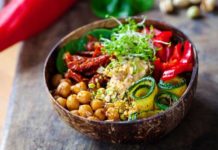
It’s resolution-making time … but should it be? As tempting as it is to go big with your goals (“I will develop the delts of Jason Momoa and the dietary discipline of a monk!”), that’s not the most effective way to make changes in your life. This year, take a different approach. Instead of making grand goal-based resolutions, resolve to create habits.
As a vegan fitness and nutrition coach, I’ve seen this approach get major results. It’s also worked for me personally. It just so happens that I went vegan on January 1. It was not meant to be a New Year’s resolution, which is one of the many reasons I’m still vegan, 17 years later.
Vegan and fit—for life
Making the transition to veganism and incorporating strength training into your daily life are two of the most powerful lifestyle habits you can adopt.
The Academy of Nutrition and Dietetics states that, when properly planned and executed, vegan diets are “healthful” and “nutritionally adequate.” The respected authority also points out that vegan diets are “appropriate for all stages of the life cycle,” including pregnancy, childhood, and older adulthood.
This means you can start any time. Eating more plant-based foods and fewer animal products will positively affect your health whether you’re a college freshman or a retiree.
The same goes for fitness. You can start at absolutely any age and make incredible progress. Aim to keep the habits you add small and sustainable. This way, you’ll set yourself up for lifelong results, and you’ll learn to love the daily processes involved in achieving your health and fitness goals.
Start by creating new—vegan—nutrition habits
Making the transition to veganism doesn’t have to be complicated, and it doesn’t have to happen all at once. My approach? Begin with the start of your day and work your way down. This could take a few weeks or a few months, but it ensures you build solid habits at each step.
Breakfast
Start by veganizing your breakfast. Try overnight oats or cooked oatmeal topped with fruit. Or a tofu scramble. Or a berry, flax, and chia seed smoothie.
Lunch
Once vegan breakfasts are your new normal, move on to lunches. These can be as simple as a PB&J sandwich and hummus with fresh veggies. They can also be more elaborate, like a Buddha bowl of black beans, cabbage, grated beets, and tempeh over a bed of brown rice—all drizzled with tahini dressing. (Is your mouth watering yet?)
Dinner
Give yourself a few weeks, then move on to dinners. The options are endless! In my household, chili, stir-fries, minestrone soup, and enchiladas are winter staples.
Support your fitness with vegan nutrition
Food quality, calories, and macronutrients are the three nutrition concepts most vital to supporting your fitness.
Food quality
High quality foods are those in their most natural states (think whole grains and fresh produce, for example) and are high in micronutrients (aka vitamins and minerals).
Preparing most of your meals in your own kitchen and focusing on filling your plate with as many whole foods as possible will ensure you’re eating a nutrient-dense diet that fuels your fitness goals.
Calories
Work with a nutrition professional to help you set calorie and macronutrient goals. Calories—a measure of the energy we get from food—are important for both athletic performance and physique goals. You’ll need to take in less energy than you burn if you’re looking to lose fat, and more energy than you burn if you’re working on gaining muscle.
Macronutrients
Macronutrients are the nutrients our bodies need in the largest amounts: carbohydrates, proteins, and fats. Each has a different function in our bodies, and we each need different ratios of these nutrients depending on our lifestyle and training.
Most of my vegan clients who strength train aim to get half their calories from carbohydrates (whole, nutrient-dense sources whenever possible), 25 to 30 percent from healthy fats, and 20 to 25 percent from protein.
And avoid these common mistakes
There’s no one right way to go vegan—you can make the transition in whatever way best suits your lifestyle. However, there are a few mistakes to avoid.
Mistake #1: Cutting out animal products without replacing them
Replace animal products with a variety of whole, plant-based foods to prevent nutritional deficiencies. Focus on sources of protein like tofu, tempeh, beans, nutritional yeast, nuts, and seeds.
Mistake #2: Fostering a mindset of avoidance
Challenge yourself to create a mindset of abundance rather than one of avoidance. Instead of focusing on all the foods you can’t eat, focus on all the new foods you can eat more of, including those you haven’t yet tried. (I had no idea what tempeh, amaranth, farro, or wakame were before I went vegan!)
Mistake #3: Neglecting to optimize your food environment
Your “food environment” consists of your surroundings and the habits you’ve built that determine what—and how—you eat. Try scheduling some time each week to prepare a large batch of a healthy vegan entree and some grab ’n’ go snacks to reduce the amount of cooking required during the week.
Now, craft your workouts
Along with a whole-food, plant-based diet, regular resistance training is a must for optimal health, fitness, and disease prevention. Resistance workouts most often involve strength training at the gym, but you can also complete bodyweight, resistance band, or suspension trainer workouts at home. Here are some tips.
If you’re just starting out, aim for three 30-minute strength training sessions per week. Once you’ve maintained this habit for about two months, you can increase the length of your workouts to 45 minutes.
If your schedule allows, you can also increase your training to four days per week, working upper body and lower body on alternating days.
To ensure you’re using correct form, I recommend working with a trainer until you’re confident you can perform each lift effectively.
When creating your workout program, make sure you’re training all the fundamental movement patterns at least twice a week: squat, hip hinge, lunge, upper body push, upper body pull, and loaded carry.
Don’t forget that habits are at the core of getting results. Instead of saying, “I’ll deadlift 100 percent of my body weight for 10 reps by the end of 2020,” try “I’ll practice deadlifts two days per week for all of 2020 and aim to increase the weight by five to 10 pounds every month.”
Supplements for your plant-based fitness plan
These supplements can help you hit your 2020 fitness goals, and vegan versions are available.
For everyone
You need 0.5 to 0.8 g of protein per pound of body weight every day if you work out. For athletes, studies have found that pea and brown rice protein shakes perform just as well as whey protein.
For strength
Creatine boosts muscle strength and muscle size and may also help with post-workout recovery. Those on a plant-based diet may have lower creatine stores, so a vegan creatine supplement can be extra helpful. Most people benefit from 5 g a day, though larger athletes may need more.
For endurance
Branched-chain amino acids (BCAAs) may reduce muscle fatigue and muscle damage, especially during endurance exercise. BCAAs may also boost post-exercise protein synthesis in your muscles by up to 22 percent. Generally, men should take 12 g of a vegan BCAA formulation daily, while women should opt for 9 g.
For fat loss
Conjugated linoleic acid (CLA) is found in animal products like grass-fed beef, but you can opt for a vegan supplement instead. CLA may help you to burn fat and increase lean muscle mass. Benefits are seen on approximately 3 g a day.
For recovery
Curcumin may protect against muscle damage and reduce muscle soreness after an afternoon in the gym. Other recovery boosters include hemp CBD oil and plant-based omega-3 fats, both of which may help with exercise soreness and inflammation.
– Joshua Duvauchelle
Making a detailed vegan nutrition plan sounds great … but how do you get a reasonably accurate idea of your calorie consumption and macronutrient ratios? The simplest way is to track your food in an app like MyFitnessPal.
Vegan fitness common myths and truths
Myth: Plants are subpar protein sources.Truth: Plants contain all the amino acids (building blocks of protein) our bodies need. As long as you’re eating a variety of whole plant foods, you’re getting good, clean protein.
Myth: If I go vegan, I’ll lose weight.Truth: A whole foods vegan diet certainly can help you lose weight, but it’s a calorie deficit, not a vegan diet, that’s responsible. Weight maintenance, as well as muscle gain, is possible on a vegan diet.
Myth: Going vegan will decrease my athletic performance.Truth: Many athletes find the opposite is true! Eating an abundance of plant-based anti-inflammatory foods (containing antioxidants and phytochemicals) can aid in recovery from training.






























